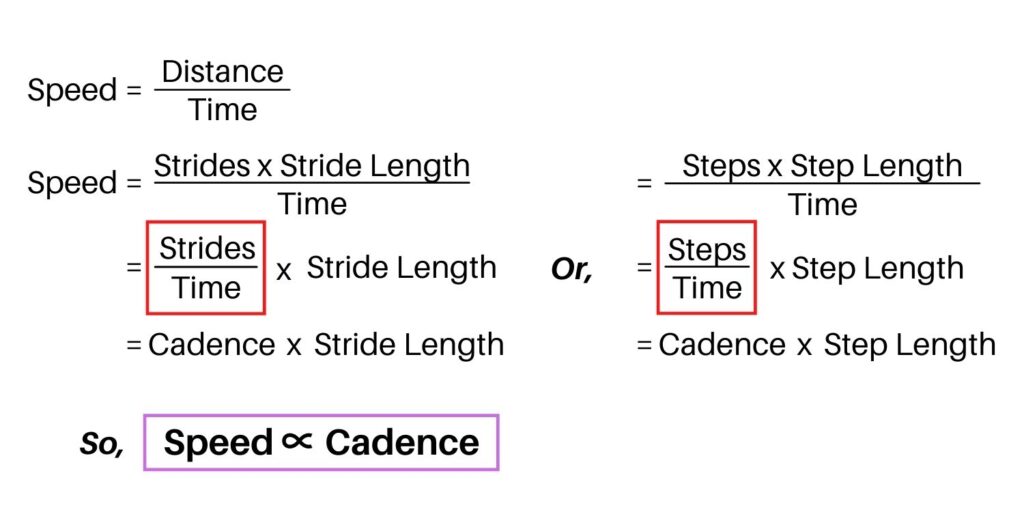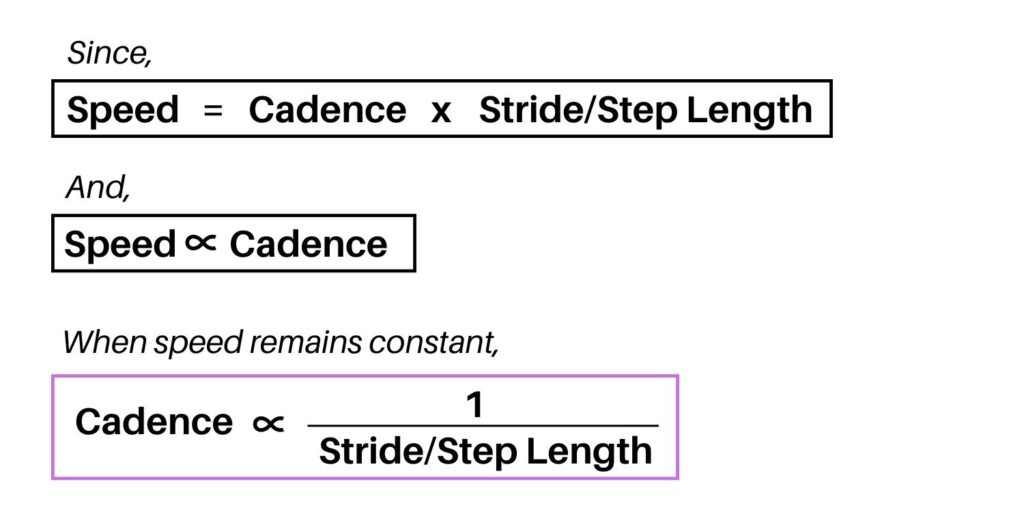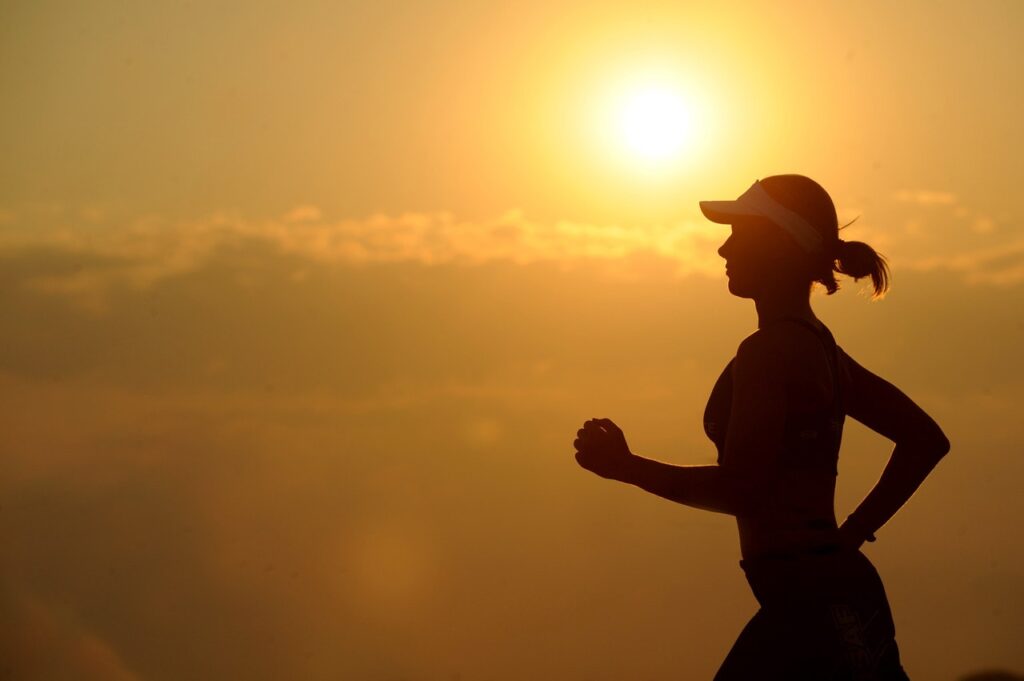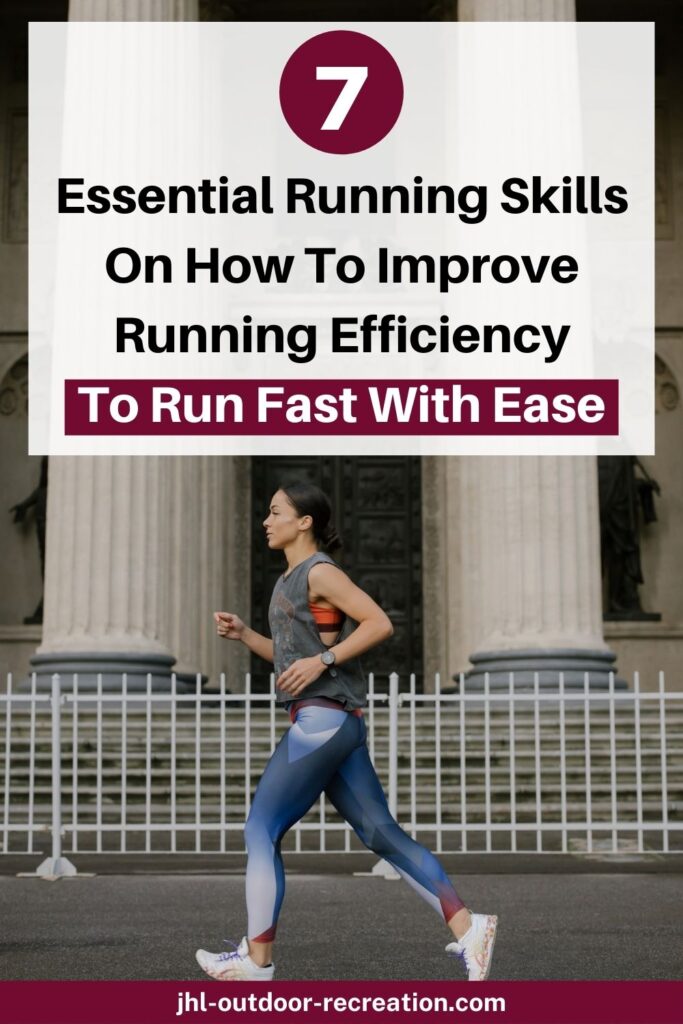As a runner, do you want to improve your running efficiency? Well, I do. I always do.
I always dream of running.
In my dreams, I feel like I have infinite amount of energy to run. I run fast without catching my breath. Besides, I surpass other runners with ease. – And I don’t even break a sweat!
Then, I wake up. Back to the reality. Sometimes, I can’t sustain my pace, and I feel like I’m struggling to run.
After the run, I am at the edge of suffocating as I can’t catch my breath. And I sweat like a pig!
That’s why it’s important to improve running efficiency. Essentially, we want to:
- Run fast
- Minimize energetic cost
- Reduce injury risk.
To run efficiently, we need decent running form.
But, how do we improve our running form to further improve running efficiency? Here comes the RUNNING SKILLS.
Back to the question above. Do you want to improve your running efficiency? – I guess you do, too, right?
So, let’s look at 7 essential running skills that we need to improve running efficiency.
1. Body tension

How tense are you when running? And, how much do you engage when running? – In short, how hard do you run?
This seems straightforward. But, we can’t really tell easily. In fact, we can look into 2 parts and assess them separately.
1.1 Upper body
Try to notice your upper body when you run. Do you have any of the following symptoms?
- Tense neck and shoulder
- Clenched fist
- Head leaning forward
- Hunched back / shoulder
These are common for tense running form. And they are nightmare of running efficiency.
When you lean your head way forward in running, your neck and shoulder sustain great stress. If you clench your fist really hard, you’re just wasting your energy.
And if you tense your neck and shoulder, and hunch your back, you can’t breathe well. Less oxygen intake, less energy, so you can’t sustain your run. – Simple as that.
Well, try to RELAX your upper body when you run. Firstly, try to loosen your grip. This helps you swing your arms with ease.
Then, relax your shoulder and neck. Let your shoulder drop to neutral position.
Besides, open up your chest. With relaxed neck and shoulder, these help you breathe and improve oxygen intake.
Lastly, try not to lean your head way too forward. To avoid this, you can look FORWARD, instead of looking down, so your head is at neutral position.
This sounds easy, but is tough to maintain. FYI, those bad habits will appear when we are exhausted when running, as our bodies get used to them.
What you can do is try to be MINDFUL whenever you can. When you feel tense up, try to remind yourself to relax. Your body needs time to adjust.
1.2 Core
So, we need to relax when running. And we might feel to relax our whole body.
Well, not really for our core. We should ENGAGE our core when running.
If we relax our core, our pelvic might tilt forward. We run wobbly and our run might not be SYMMETRICAL.
And what does it mean? It could affect body balance when running, in turns affects stability.
To counter with this, we need extra energy. – Meaning, this is inefficient.
So, we need a strong core to avoid this. A strong core makes our run steady and symmetrical, which helps preserve energy when running.
You can do PLANK when you are free. But, you need to do it the proper way. Remember to engage your core. At this point, your back is STRAIGHT and your hips muscles are tightened.
If you feel your core sore, then you are doing it properly. Try to hold it between 30 seconds and 2 minutes, depending on your core strength.
2. Breathing
We breathe in and out. When we run, our hearts beat faster as our cells need more oxygen. So, we breathe harder.
It seems natural and nothing special.
But, have you ever noticed how you breathe when running? That’s right. Breathing is vital to improve running efficiency.
And there are 3 factors of breathing, which we can look into.
2.1 Chest vs diaphragm (belly)
Are you a chest breather or a belly breather?
Do you realize many people are chest breather? I believe you do. That’s because we adore flat stomach or six packs. Thus, we suck our belly when we breathe to create this illusion. So, we breathe by using chest.
Do you know that chest breathing is bad for endurance activities, especially running? Our breaths are shallow as our lungs are not fully expanded.
And what are the impacts? You gasp for air faster when running. And you tense your shoulders and neck. You breathe harder and get tired faster. – It’s a vicious cycle.
Belly breathing, in contrast, seems awkward and ugly. We hate to see our belly rising and falling when breathing.
But, this is the NATURAL way of breathing. Look at how babies breathe. They use their belly to breathe.
What does it mean? It means we “learn” to breathe by chest.
To run better, we need to “reactivate” belly breathing. Here are simple steps for you:
- Step 1: Sit or lie down.
- Step 2: Place one palm on your belly. Place another palm on your chest.
- Step 3: Breathe in by using your belly. Your belly should rise but not your chest.
- Step 4: Breathe out. Your belly should fall and your chest remains stagnant.
- Step 5: Repeat Step 1 to Step 5.
- Step 6: Try to mimic the same when running. Be mindful when breathing.
2.2 Nose and mouth
We either breathe through nose or mouth when running. Sometimes, we use both.
Usually, we breathe though nose. That’s because our nose helps keep the warmth and moisture of air. – Well, many runners prefer breathe in through nose and breathe out through mouth.
But, if you’re exhausted when running, you need more oxygen. So, you may breathe through mouth. You get more oxygen. But, you might tense your neck and shoulders easier as you might breathe too hard.
Try to breathe in through your nose whenever you can.
2.3 Pattern
This refers to how your breath SYNCS your cadence.
For example, you might see 3:2 breathing pattern. – This simply means breathe in for every 3 steps and breathe out for every 2 steps.
So, the common breathing patterns include: 3:2, 2:2, 2:3, 3:3.
Do you notice these patterns can either be ODD or EVEN? – In fact, this is similar to breathing pattern when swimming front crawl.
I’d call the Even patterns, ie 2:2 and 3:3, UNILATERAL breathing. This means the steps and breathing are always synced in one side. This might create a dominant side, which result in unbalanced gait.
In contrast, the Odd patterns, ie 3:2 and 2:3, are BILATERAL breathing. The footsteps are reciprocal, which stimulate footsteps of both sides. Hence, the gait is more balanced.
Nonetheless, it doesn’t mean bilateral breathing is superior. The bottom line is CONSISTENCY in breathing.
Try not to change your pattern often while breathing. Irregular breathing pattern can affect your heartbeat.
3. Cadence

By referring this, cadence is the step / stride frequency.
And it has direct relationship with speed. So, when cadence goes up, running speed goes up, too.
In fact, cadence is bread and butter if you want to improve running efficiency. By reworking your cadence, you can potentially:
- Run faster with less amount of energy
- Reduce ground contact force, ie. reduce risk injuries
3.1 Optimal cadence
That’s why many runners strive to rework their cadence to improve running efficiency. And you come across the magic cadence, 180 steps per minute (spm).
So, they strive to achieve this to run like elite runners. But, it isn’t a one-size-fit-all cadence.
Even elite runners can run way beyond this cadence, 200 spm for instance.
There are indeed many factors that influence optimal cadence. In a study published by PLOS ONE, the optimal running stride frequencies of inexperienced runners are 83 strides per minute (166 spm).
So, if they ran at 180 spm, they might not be able to sustain it. But, they could aim to run at 166 spm, which is more doable.
In contrast, although 180 spm might not be suitable for all experienced runners, it is still a good benchmark. At least they can use this as a basis to improve their cadence.
3.2 How to improve cadence
Let’s break down into some simple steps
- Step 1: Be aware of the challenge to change cadence. But, we can still make it.
- Step 2: Count your natural cadence. Then work on the new cadence. To count cadence, you can count in mind, use metronome app / smartwatch, or use music.
- Step 3: Make this session 2 or 3 times per week. Or, you can practice this as your warming up session for your run.
- Step 4: Include some drills, such as high-knee drill, rope jumping, or butt-kick drill.
- Step 5: Repeat Step 2 to Step 4. Be persistent.
4. Stride
A stride simply means the distance between TWO steps taken.
Bear in mind where stride and steps can be used INTERCHANGABLY in running. For example, over-striding means runners exaggerate every STEP. It doesn’t mean they only exaggerate every other step.

And if you refer to the diagram , you’ll notice stride has a direct relationship with speed as well. Meaning, increasing stride length can lead to increasing speed.
Meanwhile, stride and cadence have INVERSE relationship. – Meaning, they might counteract each other, which lead to speed remains constant.
For this purpose, we can look into 2 factors.
4.1 Common problem
Here you are with the infamous over-striding and under-striding
4.1.1 Over-striding
This issue is common in running. This is where runners exaggerate their strides and land way beyond the centre of mass.
Over-striding is usually caused by low cadence and heel-striking (discussed below).
But, it doesn’t mean all heel strikers over-stride. Likewise, some forefoot or mid-foot strikers might over-stride.
The impact could be serious, which impact running, climbing stairs, or normal walking. In a clinical study, 9 patients (with different running backgrounds) experienced inward knee pain. All of them are heel strikers who also over-stride.
6 patients received gait training to retrain their cadence (increase cadence). The goal is to reduce or fix over-striding.
After the treatment, the patients experienced relief of inward knee pain.
So, do you think over-striding lead to knee pain / injury?
4.1.2 Under-striding
We seldom hear this as this is less common than over-striding. Plus, the impact is not as great as over-striding.
Nonetheless, runners who have excessive cadence might cause under-striding. Typically, this is inefficient as the run might be rushed and not be in full range of motion.
Meaning, the runners do not maximize their power and strength when running.
4.2 Leg movement
It’s possible to maximize running speed by optimizing both cadence and stride length. And elite runners are perfect examples.
Assess their running form. They have wide stride length and high cadence. And they seem running with ease. How do they maintain such a nice stride length?
Unlike cadence, it’s hard to identify optimal stride length, unless we have specific device to measure it.
But, we can improve it by working on leg movement.
- Step 1: When running, focus on “PUSHING” your rear leg.
- Step 2: After you push off the ground, lift your ankle of your rear leg so it moves closer to your butt. This allows your rear foot “swing” to the front.
- Step 3: Here’s the point where your rear leg becomes front leg. Lift the knee to further complement the swinging of your leg.
- Step 4: Then, place your step beneath your body or close to the centre of mass to avoid over-striding. And repeat the cycles.
It doesn’t matter if you jog or run. They work the same.
I used to only focus on lifting my front leg when running. It turned out my form was ugly, as if I was marching. And my run looked heavy, too.
5. Foot striking
In running, runners classify themselves as either heel strikers or forefoot / mid-foot strikers.
Have you ever notice how your feet land on ground when running? Do you land with your heels or with the ball of foot / mid-foot?
There is always a long debate between heel strike and forefoot / mid-foot strike. – Ok, so which one is better?
5.1 Heel striking
Runners who land on the ground with heels are heel strikers.
You might notice heel striking is a poor technique for running as it causes knee injuries. Technically, there are 2 reasons for that:
- Our knees directly absorb the shock when landing.
- Heel striking often leads to over-striding.
When this is not addressed, it might impair the strength of our knees. Over the time, we might have problems in running or even walking.
The 9 runners (patients) of the clinical study above show similar results. All of them had inwards knee pain, and they were heel strikers with over-striding.
Some of them had acute pain, which impacted their daily lives.
5.2 Forefoot / mid-foot striking
Runners who land on the ground mid-foot are mid-foot strikes. Likewise, forefoot strikers are runner who land with the ball of foot.
These two are often grouped together (due to similar nature) and compared with heel strikers.
Arguably, forefoot / mid-foot striking are better than heel striking due to:
- Our ankles absorb shocks when landing, which act as cushions to reduce the impact of our knees
- Promote landing closer to the centre of mass, which reduce the chance of over-striding
- Promote leaning forward when running
Nonetheless, forefoot / mid-foot runners might experience pain or injuries on ankles, achilles tendon, or shin.
5.3 Bottom line
Despite the comparison results, it doesn’t mean mid-foot / forefoot striking are the only ways to run.
And talk about the design of modern running shoes. Many running shoes have top-notch cushions, which help absorb shocks for heel strikers. – This helps prevent knee injuries.
Speaking of injury, over-striding is the core issue. Not all heel-strikers over-stride. In contrast, some mid-foot / forefoot strikers over-strike.
And guess what? Many elite runners are heel strikers. And they run much faster and better than most runners.
As long as you run fast, do not struggle, and have no sign of injuries, your foot strikes should be fine.
6. Arm swing

Arm swing is natural for walking, running, and sprinting. So, we rarely pay attention to it.
This seems trivial in running. Hence, they are always less focused when we want to improve running efficiency.
In fact, arm swing is a core area for sprinting. Even for jogging / distance running, arm swing also plays a vital role.
6.1 Purposes of arm swing
These include:
- Improving lateral balance
- Reducing energetic cost (save energy).
A study published by Journal Of Biomechanics assessed the effects of step width and arm swing on energetic cost and lateral balance.
At the end of the study, the researchers found that:
- The net metabolic power demand increased by 8% when running without arm swing compared to running with arm swing
- Running without arm swing increased step width variability by 9%.
What do the results mean?
Step width variability refers to lateral balance. The greater the variance is, the weaker the balance is.
And the increase in net metabolic power demand means extra energy needed when running.
In other words, running without arm swing upsets lateral balance. And our body needs extra energy to counter with this when running.
In short, running without arm swing wastes energy.
6.2 How to swing arms properly
Arm swinging seems simple, but there are a few points to note:
- Relax your shoulders and open up your chest.
- Loosen your grip (firm but not tight).
- Engage your shoulder to swing your arms, instead of your arms.
- Make sure your arms don’t cross the middle axis of your body.
7. Leaning forward
We stand tall and straight when walking. And since running is a fast version of walking, we should also maintain the same posture.
And here there are many runners who run like that.
But, do you know we should lean our body forward when running?
Precisely, running is a state of CONSTANT FALLING.
7.1 Purposes of leaning forward
These include:
- Reducing chance of over-striding
- Running faster
When we lean our body forward, we also shift our centre of mass the same way. Then, gravity helps us run. – An extra force to propel you.
You can do this yourself. When you are leaning and about to fall, your leg will naturally step forward.
Watch your footstep. Your leg will land right under your body. Also, you either strike forefoot / mid-foot.
Imagine you keep repeating this process. You constantly fall and maintain the posture. And you keep moving forward.
There you go. This is the ideal way of running.
7.2 Challenge
To me, I find this the hardest to adapt to running.
It feels strange as we have the fear of falling. And to avoid this, some bend their WAIST forward to mimic this leaning posture.
This isn’t right. Instead, we should bend from our ANKLES so our body remains straight.
As we aren’t familiar in doing this, we might OVER-LEAN, which might cause muscle strain or even injuries.
Final thought: how to improve running efficiency
There you are the 7 essential running skills on how to improve running efficiency.
To be a good runner, not only do we need to run fast, but also to run with ease and reduce injury risk.
You might find it info overload. But, that’s fine.
This isn’t a detailed post to teach you how to improve running efficiency, but gives you a GENERAL IDEA of essential running skills.
So, I hope this can help you improve running efficiency.
Relevant posts
